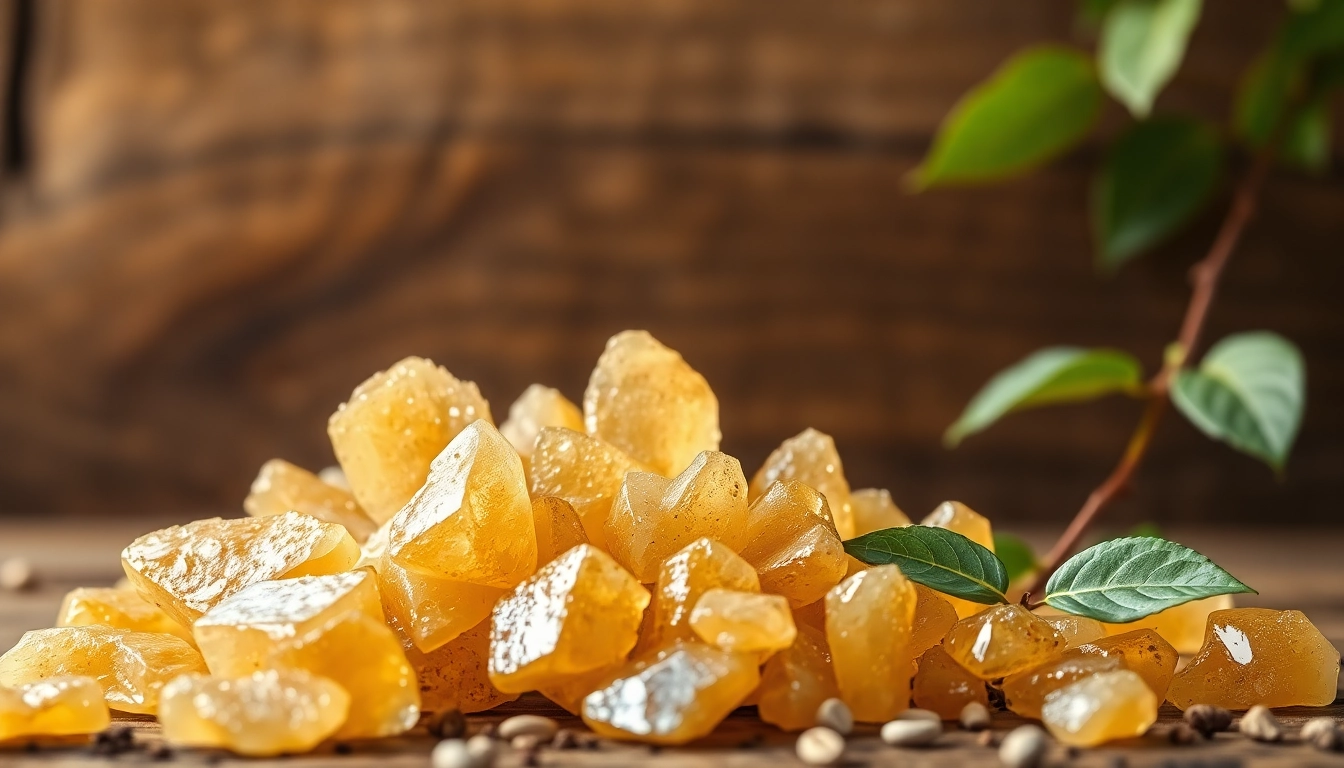
Introduction to Myrrh: History and Origin
Myrrh is a resinous substance derived from the Commiphora tree, primarily found in regions of Africa and the Arabian Peninsula. Traditionally, it has played a vital role in various cultures throughout history, especially within ancient civilizations. Known for its distinctive aromatic properties and numerous therapeutic benefits, myrrh has remained a staple in natural remedies and spiritual practices for millennia.
1.1 What is Myrrh?
Myrrh, botanically classified under the genus Commiphora, consists of a gum resin collected from the bark of certain species of the Commiphora tree. It is characterized by its amber hue and a somewhat bitter yet aromatic flavor. The resin has a long-standing application in incense, perfumery, and as a potent medicinal ingredient in various herbal formulations. The primary components of myrrh include terpenoids, sesquiterpenes, and essential oils, which contribute to its health-giving properties.
1.2 Historical Significance of Myrrh
The significance of myrrh can be traced back to ancient Egypt, where it was used in embalming practices. This sacred resin held spiritual connotations, often associated with deities and divine protection. In biblical texts, myrrh is mentioned in connection with the gifts of the Magi to the Christ child, emphasizing its value and spiritual importance. Beyond its religious ties, myrrh was regularly utilized by ancient Greeks and Romans as a remedy for ailments, illustrating its historical role as a multi-faceted substance. Its historical track record positions myrrh not only as a valuable commodity but also as a symbol of healing and tradition.
1.3 How Myrrh is Harvested
The process of harvesting myrrh involves several stages, beginning with the careful selection of mature Commiphora trees known for producing high-quality resin. Harvesters make incisions in the bark of the tree, allowing the sap to ooze out and harden into small resin droplets. This extraction process typically occurs in arid conditions, which are ideal for resin quality. Once the sap coagulates, it is collected by hand, ensuring that the process remains sustainable and minimizes harm to the host trees. The resin is then cleaned and sun-dried, closely monitored to preserve its beneficial properties before being packaged for distribution.
The Health Benefits of Myrrh
Myrrh’s therapeutic applications have been validated through both historical tradition and modern scientific research. For many herbalists and natural health enthusiasts, myrrh serves as a powerful ingredient with various health benefits ranging from its anti-inflammatory properties to its potential as an antioxidant.
2.1 Antioxidant Properties of Myrrh
The antioxidant properties of myrrh are attributed to its high levels of essential oils and terpenoids, which help neutralize free radicals in the body. Free radicals are unstable molecules that can cause oxidative stress, contributing to various chronic diseases and aging. By incorporating myrrh into a health regimen, individuals may enhance their bodily defense mechanisms against oxidative stress. Recent studies have underscored myrrh’s potential in reducing markers of oxidative stress, further establishing its role as an efficient natural antioxidant.
2.2 Myrrh for Inflammation Relief
Chronic inflammation is a root cause of various health issues, including arthritis, diabetes, and even cancer. Myrrh has been traditionally recognized for its potent anti-inflammatory properties. Several studies have revealed that myrrh resin can help modulate inflammatory pathways, demonstrating its potential effectiveness in reducing inflammation-related conditions. Additionally, the application of myrrh extracts in topical preparations shows promise in alleviating swelling and pain associated with inflammatory illnesses.
2.3 Traditional Uses in Herbal Medicine
Throughout history, myrrh has found its place in traditional herbal medicine, addressing a variety of ailments. Its applications range from treating sore throats and respiratory issues to supporting digestive health. Myrrh has been known to act as an antimicrobial agent, helping treat infections. Herbalists recommend it for its use in soothing gum inflammation and promoting oral health due to its antimicrobial and analgesic properties. Formulations often include myrrh tinctures and infusions, further enhancing its utilization in home remedies.
Myrrh: Types and Quality
Not all myrrh is created equal, and understanding the varieties and their qualities can significantly enhance the user experience in both therapeutic and aromatic applications.
3.1 Different Varieties of Myrrh
There are several types of myrrh, each derived from different species of Commiphora. The most recognized are Commiphora myrrha, which yields “true myrrh,” and Commiphora molmol, often referred to as “Somali myrrh.” Each variety boasts unique chemical compositions and properties, with true myrrh being highly regarded for its medicinal attributes. The selection of a specific type depends largely on its intended use—whether for aromatherapy, topical application, or internal use.
3.2 How to Identify Quality Myrrh
When sourcing myrrh, quality is paramount. Authentic myrrh should appear as brownish-yellow to red-brown tears, with a glossy surface. Upon smelling, the aroma should be rich and slightly bitter, indicative of high resin content. Avoid products that contain additives or fillers, as these diminish the therapeutic potential of the resin. Ensuring that the myrrh is sourced from reputable suppliers who provide lab analysis can help in confirming its purity.
3.3 Tips for Storing Myrrh
To maximize the shelf life and efficacy of myrrh, proper storage is essential. Myrrh should be kept in a cool, dry place away from direct sunlight, ideally in an airtight container to prevent oxidation. It’s advisable to label the container with a date of purchase to keep track of freshness. If using myrrh in oil or tincture form, ensure that the bottle is tightly sealed and stored upright to prevent leakage.
Incorporating Myrrh into Your Daily Routine
Integrating myrrh into your daily life can enhance wellness and add a touch of natural remedy to your routine. There are several strategies for incorporating myrrh effectively, from essential oil applications to health supplements.
4.1 Myrrh in Essential Oils
Myrrh essential oil is celebrated for its aromatic qualities and therapeutic benefits. It can be diffused in the air to promote a calming environment or diluted with carrier oils for topical use. When used in skin care, it can aid in the repair of damaged tissues and promote skin health. A few drops mixed into your favorite moisturizer enhances its restorative properties, providing nourishment to dry or irritated skin.
4.2 Myrrh in Supplements and Extracts
For those who prefer a more concentrated form of myrrh, supplements or tinctures are widely available. Myrrh capsules can be an effective way to reap the internal health benefits, including support for digestive and immune functions. Always consult a healthcare provider before starting any new supplement regimen to ensure its safety and suitability for personal health needs.
4.3 Recipes for Myrrh-infused Products
Creating myrrh-infused products at home can enhance personal care items. For a simple myrrh-infused oil, combine myrrh resin with a carrier oil such as jojoba or sweet almond oil, allowing it to steep for a few weeks in a warm, dark place. This infusion can be used as a massage oil or in homemade skin balms, merging the therapeutic attributes of myrrh with skin-nourishing oils.
Precautions and Considerations
While myrrh is considered safe for many individuals, there are important considerations and precautions to keep in mind before incorporating it into health routines.
5.1 Possible Side Effects of Myrrh
Generally, myrrh is well tolerated; however, some individuals may experience mild side effects, particularly with excessive use. Possible reactions include gastrointestinal discomfort, skin irritation, or allergic responses. Conducting a patch test prior to topical application can help identify any adverse reactions.
5.2 Interactions with Medications
Myrrh may interact with various medications, particularly those affecting blood clotting or blood sugar levels. If you are taking anticoagulants or medications for diabetes, it is crucial to discuss the use of myrrh with your healthcare provider to avoid potential complications.
5.3 Consultation with Healthcare Providers
As with any herbal supplement or remedy, consulting with a healthcare provider is advisable, especially for pregnant or breastfeeding individuals, or those with pre-existing medical conditions. This ensures that myrrh can be incorporated safely and effectively, reinforcing a holistic approach to health and wellness.






